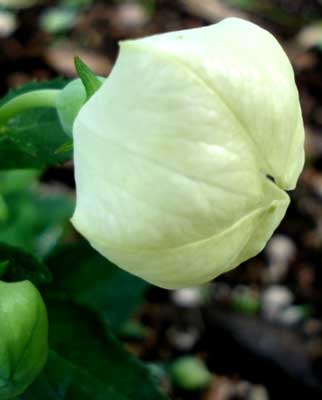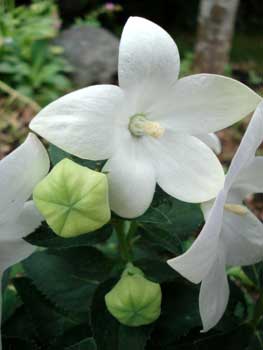
Doraji,
White Balloon Flower
"I need a white balloon that I can ride
To fly with the angels across the sky."
-Allison Morgan,
2005
The white variant balloon flower (Platycodon grandiflorus var. albus 'Fuji White') probably originated in Korea, though after millenia gardened, it has naturalized throughout China as far as East Siberia. In Korea it is called Doraji, which became Toraji in Japanese.2005
Doraji balloon flowers have a considerable folklore attached. A popular folksong originating in Korea is well known in Chinese & Japanese versions too, though when Koreans sing it, the flower represents nation itself:
 "I walk the mountain trail where the Doraji blooms; nostalgic for my youth am I/ These white flowers remind me of my mother & the twinkling stars of the sky/ I wear these flowers in my hair, I tread with memories & sighs." You can hear the sweet melody performed by Korean students here.
"I walk the mountain trail where the Doraji blooms; nostalgic for my youth am I/ These white flowers remind me of my mother & the twinkling stars of the sky/ I wear these flowers in my hair, I tread with memories & sighs." You can hear the sweet melody performed by Korean students here.Large five-petalled blooms make quite an impression. Before they open, they are momentarily a perfect "balloon" which is this flower's most charming trait. Because the number "five" connotes special magic in Taoism, it is a flower that is said to reflect the entlirety of the universe, both as a singlular whole (as a balloon) & as a symbol of the five elements (wood, fire, earth, metal, & water).
Throughout Asia, the starchy taproots, when washed & blanched briefly in boiling water, are regarded as a healthful vegetable. Dried doraji root is commonly available in Korean specialty stores. These should be soaked in water overnight, then wrung out & patted dry & rubbed with salt, then soaked again & wrung out & salt-rubbed at least two more times, once per hour.
It will be much too bitter if you try to skip the soaking & wringing & the salt-rubs. It's the salt that draws out the bitter component. However, some Korean recipes assume some people like it bitter & so don't give it the salt-rub. If you didn't get the pre-shredded version, it must now be torn into strings, or cut short. Blanche in boiling water for five to ten minutes, & pat dry one last time.
It is now ready to prepare as a side dish with spices, or to add to clear soups. As a traditional salad by itself, start with three tablespoons sugar or honey to be dissolved into rice vinegar or balsamic vinegar (it will need to be heated to dissolve the sugar completely). If you want it hot & spicy, mix in two tablespoons of red pepper powder (for me, skip that). Squeeze a clove of garlic into the sweetened vinegar, mix with one teaspoon of sesame oil, & dampen the fibrous doraji. Finely chop the squeezed garlic plus grate a tiny amount of ginger or scallion to toss into the doraji. Top off with a sprinkle of toasted sesame seeds. And there ya go, a Buddhist vegetarian treat, called shojin style in Japanese.
More elaborate doraji recipes can be had from any Korean cookbook, & a few Japanese or Chinese cookbooks. It's hard to sacrifice a clump from the garden, but if you do dig out a balloon flower for the fresh root, you'll find a single three-year-old plant has quite a lot of taproot to work with. It may need pounding before it can be shredded, & the soaking process will be a little quicker not requiring the overnight first-soak that dried doraji needs.
The root is also used as an anti-flammitory medicine in Chinese herbalism, & its chemical properties have been investigated for the possibility of lowering cholesterol. In Japan it is an ingredient in an alcholic beverage imbibed for New Years.
Continue to:
Platycodon grandiflorus 'Fuji Blue'